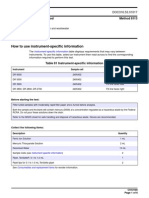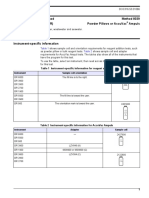ACRN 5 6 Aldehydes
ACRN 5 6 Aldehydes
Uploaded by
Carmen AzuaraCopyright:
Available Formats
ACRN 5 6 Aldehydes
ACRN 5 6 Aldehydes
Uploaded by
Carmen AzuaraCopyright
Available Formats
Share this document
Did you find this document useful?
Is this content inappropriate?
Copyright:
Available Formats
ACRN 5 6 Aldehydes
ACRN 5 6 Aldehydes
Uploaded by
Carmen AzuaraCopyright:
Available Formats
Method:
ACRN-5
Revision:
6 Final
Revision Date: 08/15/07
Last Review: 08/15/07
Next Review: 08/15/11
Acrylonitrile
Specification Tests
Aldehydes
Page 1 of 6
Reviewed by: Karen Runge
METHOD SUMMARY
The aldehydes in the sample are reacted with 3-methyl-2-benzothiazolinone
hydrazone hydrochloride (MBTH) and then with an oxidizer to form a blue color
whose intensity is proportional to the concentration of aldehydes present. The
intensity of the blue color is measured spectrophotometrically at about 620 nm and
is converted to ppm aldehydes as acetaldehyde by means of a calibration curve
prepared from standards of known concentrations of acetaldehyde. Detection
range is 2-20 ppm. Repeatability for an individual analyst should be better than 2.5
ppm.
SAFETY
Acrylonitrile is hazardous to the health and dangerous to handle. Use acrylonitrile
in a well-ventilated hood. Review the MSDS for detailed information concerning
toxicity, first aid procedures and safety precautions.
Refer to the appropriate safety section or site manual for the necessary protective
equipment to use when handling any reagents or samples.
REFERENCES
STM C17-76 (SOHIO Test Method) "Aldehyde in Acrylonitrile"
INTERFERENCES
The inhibitor, MEHQ, usually present in acrylonitrile, will react with the oxidizing
reagent to produce a color that interferes with this procedure. The inhibitor is
Technical information contained herein is furnished without charge or obligation, and is given and accepted at recipients sole risk.
Because conditions of use may vary and are beyond our control, INEOS USA LLC makes no representation about, and is not responsible
or liable for the accuracy or reliability of data, nor for toxicological effects or Industrial Hygiene requirements associated with particular
uses of any product described herein. Nothing contained in this document shall be considered a recommendation for any use that may
infringe patent rights, or an endorsement of any particular material, equipment, service, or other item not supplied by INEOS USA LLC.
The Properties and Applications listed in this document are not specifications. They are provided as information only and in no way
modify, amend, enlarge, or create any specification or warranty, and ALL WARRANTIES, EXPRESS OR IMPLIED, INCLUDING
WITHOUT LIMITATION THE WARRANTIES OF MERCHANTABILITY AND FITNESS FOR A PARTICULAR PURPOSE, ARE
EXCLUDED.
October 2006
2006 INEOS USA LLC
This document is UNCONTROLLED. For the latest revision of this test method, visit
http://techservice.innovene.com and select Acrylonitrile in Browse by Product.
Method:
ACRN-5
Revision:
6 Final
Revision Date: 08/15/07
Acrylonitrile
Specification Tests
Last Review: 08/15/07
Aldehydes
Next Review: 08/15/11
Page 2 of 6
Reviewed by: Karen Runge
removed by washing the sample with dilute caustic or by distillation. About 65% of
the acrolein present will also react.
APPARATUS AND REAGENTS
1.
MBTH Color Reagent, (0.08 g/L)
The solution may be prepared in the following manner: Dissolve 0.08 gm of
3-methyl-2 benzothiazolinone hydrazone hydrochloride in water and dilute
to 1000 mL. Store in a brown bottle.
Note: Fresh color reagent should be used with each new calibration curve
and replaced monthly. Using color agent longer will result in bias high
results.
2.
Oxidizer Reagent
The solution may be prepared in the following manner: Add 8.33 gm ferric
chloride (FeCl3 . 6H2O) and 8.0 gm sulfamic acid to a 1000 mL volumetric
flask. Dissolve in water and dilute to volume. Store in a brown bottle.
3.
Spectrophotometer - Hitachi U2000 or equivalent (CAL-1).
4.
Quartz Cells. 1 cm pathlength
5.
Acetaldehyde - Eastman #468 or equivalent. This should be re-distilled
prior to use as a standard at least every month. This may be done using
helium as a carrier gas and an ice water solution as the coolant for the
condenser.
6.
ASTM Type II water , or equivalent. Minimum electrical resistivity 1.0
M cm at 298 K; maximum total organic carbon 50 g/L; maximum sodium
5 g/L; maximum chlorides 5 g/L; maximum total silica 3 g/L. Detailed
specifications can be obtained from ASTM: www.astm.org.
7.
Syringes, 50 L, 10 L.
8.
Balance, analytical, readability to 0.1 mg.
This document is UNCONTROLLED. For the latest revision of this test method, visit
http://techservice.innovene.com and select Acrylonitrile in Browse by Product.
Method:
ACRN-5
Revision:
6 Final
Revision Date: 08/15/07
Acrylonitrile
Specification Tests
Last Review: 08/15/07
Aldehydes
Next Review: 08/15/11
Page 3 of 6
Reviewed by: Karen Runge
9.
MEHQ, (4-methoxyphenol), CP grade.
10.
3-Methyl-2-benzothiazolinone hydrazone hydrochloride [CAS 4338-981] Fisher EK119-8688 or equivalent.
11.
Ferric chloride hexahydrate, [CAS 10025-77-1] ACS reagent grade,
Aldrich 23,648-9 or equivalent.
12.
Sulfamic Acid, [CAS 5329-14-6] 99%, Aldrich 24,277-2 or equivalent.
13.
Acrylonitrile, inhibitor free.
14.
Sodium Hydroxide, 5N. The solution may either be purchased (ACS
Certified) or be prepared in the following manner: Add 200 g of reagent
grade sodium hydroxide to ~ 600 mL of water. Dissolve and dilute to 1 liter.
15.
Volumetric flasks, 50 mL, Class A
16.
Pipettes, 1, 2, 25 mL, Class A
17.
Separatory funnel, 2L with stopper.
18.
EPA Vials: 40 mL plus teflon lined septum and screw cap.
CALIBRATION
Inhibitor Removal
Remove the inhibitor by one of the following procedures:
1.
Extraction - To a 2 liter separatory funnel, add 600 mL of acrylonitrile, 540
mL of water and 60 mL of 5N sodium hydroxide. Shake, allow solution to
separate into layers, and discard the bottom layer. Add 600 mL of water,
shake, allow solution to separate and discard the bottom layer. This
procedure may also remove some aldehydes.
2.
Distillation - Distill at least 95% of the acrylonitrile. The distilled material from
the distillation test may be used for MEHQ free acrylonitrile.
Both procedures to remove the inhibitor may also remove some aldehyde.
This document is UNCONTROLLED. For the latest revision of this test method, visit
http://techservice.innovene.com and select Acrylonitrile in Browse by Product.
Method:
ACRN-5
Acrylonitrile
Specification Tests
Revision:
6 Final
Revision Date: 08/15/07
Last Review: 08/15/07
Aldehydes
Next Review: 08/15/11
Page 4 of 6
Reviewed by: Karen Runge
Standard Preparation
Stock Solutions
1.
Weigh five 40 mL EPA vials with Teflon-lined septa and screw cap.
2.
In a hood, add 40 mL of scrubbed acrylonitrile at room temperature to each
vial.
3.
Weigh each stock solution just prior to and just after the acetaldehyde
addition. Using an ice cold 50 L syringe, add about 0, 10, 20, 30 and 40 L
of the distilled, chilled acetaldehyde below the acrylonitrile surface.
4.
From the weight added, calculate the ppm acetaldehyde added to each of the
vials (Stock Solutions):
Acetaldehyde, ppm = [W1 (W1 + W2)] x 106
Where:
W1 = weight acetaldehyde added, g.
W2 = weight acrylonitrile, g.
Standard Solutions
1.
Dilute each Stock Solution with acrylonitrile to give the desired acetaldehyde
standards by pipetting 1.0 mL of each above stock solution into another 50
mL volumetric flask containing about 40 mL scrubbed acrylonitrile, then dilute
to volume with the scrubbed acrylo, stopper tightly and mix thoroughly.
2.
Calculate ppm acetaldehyde added in each standard.
For Example: 250.3 ppm x 1 mL 50 mL = 5.01 ppm acetaldehyde added.
3.
Pipette 25 mL of MBTH solution and 1.0 mL of the standard into a 50 mL
volumetric flask. Let sit for 45 + 5 minutes.
4.
Pipette 2.0 mL of the oxidizer reagent into each flask. Dilute to volume with
water and mix thoroughly. Let sit for 20 + 1 minutes.
This document is UNCONTROLLED. For the latest revision of this test method, visit
http://techservice.innovene.com and select Acrylonitrile in Browse by Product.
Method:
ACRN-5
Revision:
6 Final
Revision Date: 08/15/07
Acrylonitrile
Specification Tests
Last Review: 08/15/07
Aldehydes
Next Review: 08/15/11
5.
Page 5 of 6
Reviewed by: Karen Runge
Scan the 4th standard from 700 to 600 nm and measure the absorbance
against the blank. Use the Trace option in the Hitachi to find the maximum
absorbance (~ 620 nm).
6.
Determine the absorbance of each standard against the 0 standard at the
maximum absorbance wavelength.
7.
After the determination of the last standard, a 1st order linear curve will be
generated by the program in the Hitachi. If the data points (+s) are in good
agreement with the instrument generated line, then store the curve. If one
or more points are in poor agreement, repeat those and replot.
8.
Enter the date, worksheet(s), initials of calibrator and any comments in the
appropriate log.
PROCEDURE
1.
Remove the inhibitor from the sample by extraction or distillation as outlined
in the calibration procedure.
2.
Pipette 1.0 mL of the sample into a 50 mL volumetric.
3.
Pipette 25 mL of MBTH solution into each flask and let sit for 455 min.
4.
Add 2 mL of the oxidizer reagent into each flask. Dilute to volume with water
and mix thoroughly.
5.
Let set for 201 min.
6.
Measure the absorbance at the maximum near 620 nm in the same manner
as the standards.
CALCULATIONS
The sample ppmw will be calculated using the stored value from the slope and
intercept in the Hitachi.
REPORT
This document is UNCONTROLLED. For the latest revision of this test method, visit
http://techservice.innovene.com and select Acrylonitrile in Browse by Product.
Method:
ACRN-5
Revision:
6 Final
Revision Date: 08/15/07
Last Review: 08/15/07
Acrylonitrile
Specification Tests
Aldehydes
Next Review: 08/15/11
Page 6 of 6
Reviewed by: Karen Runge
Report aldehyde as acetaldehyde to the nearest ppm:
aldehydes, ppmw = 4
This document is UNCONTROLLED. For the latest revision of this test method, visit
http://techservice.innovene.com and select Acrylonitrile in Browse by Product.
You might also like
- ASTM D6560 AsfaltenosDocument5 pagesASTM D6560 AsfaltenosCarlos Garcia CerqueraNo ratings yet
- Nitrogen, Total Kjeldahl: How To Use Instrument-Specific InformationDocument8 pagesNitrogen, Total Kjeldahl: How To Use Instrument-Specific InformationivanpajolliNo ratings yet
- Cod Procedure For HACH DR 2800Document8 pagesCod Procedure For HACH DR 2800Berliana Cahya NingtiasNo ratings yet
- A Laboratory Manual of Physical PharmaceuticsFrom EverandA Laboratory Manual of Physical PharmaceuticsRating: 2.5 out of 5 stars2.5/5 (2)
- Thermodynamics Lab ManualDocument9 pagesThermodynamics Lab ManualEr Shankar Singh Dhami100% (2)
- Oxygen Demand, ChemicalDocument10 pagesOxygen Demand, ChemicalPetrovic NenadNo ratings yet
- Organic Carbon Total HR TNT 10128Document8 pagesOrganic Carbon Total HR TNT 10128okgnosasNo ratings yet
- Chloride 8113Document6 pagesChloride 8113okgnosasNo ratings yet
- Chlorine Free DPDDocument8 pagesChlorine Free DPDEndang SupriyatnaNo ratings yet
- HACH Chloride by Thiocyanate-Method No.8113-DOC316.53.01017 - Ed7Document6 pagesHACH Chloride by Thiocyanate-Method No.8113-DOC316.53.01017 - Ed7Balas43No ratings yet
- DOC316.53.01099 Ed10Document10 pagesDOC316.53.01099 Ed10zvjesosNo ratings yet
- Nitrate PDFDocument10 pagesNitrate PDFUmi NazaliaNo ratings yet
- DR 4000 Chemical Oxygen Demand (All Ranges) Method 8000Document4 pagesDR 4000 Chemical Oxygen Demand (All Ranges) Method 8000Andrea D'AmoreNo ratings yet
- By Authority of Legally Binding Document: The United States of AmericaDocument14 pagesBy Authority of Legally Binding Document: The United States of AmericaRay Peramathevan RavendranNo ratings yet
- Hydroxyl Value (Hindered Hydroxyls) : Lubrizol Standard Test ProcedureDocument3 pagesHydroxyl Value (Hindered Hydroxyls) : Lubrizol Standard Test Procedurecarlos_bautista_55No ratings yet
- Quartenary Ammonium Compound TetDocument6 pagesQuartenary Ammonium Compound TetSaras Unggul UtamiNo ratings yet
- Arsenic: Silver Diethyldithiocarbamate Method Method 8013 0 To 0.200 MG/L AsDocument8 pagesArsenic: Silver Diethyldithiocarbamate Method Method 8013 0 To 0.200 MG/L AsaldiniNo ratings yet
- Arsenic: Silver Diethyldithiocarbamate Method Method 8013 0 To 0.200 MG/L AsDocument8 pagesArsenic: Silver Diethyldithiocarbamate Method Method 8013 0 To 0.200 MG/L AsAngel David Bedoya MartinNo ratings yet
- Uop 481 - 10Document13 pagesUop 481 - 10lovehackinggalsNo ratings yet
- 6015 RevDocument7 pages6015 RevAdem YildirimNo ratings yet
- Method 11 PDFDocument28 pagesMethod 11 PDFMichael StevenNo ratings yet
- Nitrogen, Ammonia, LR TNT, 0 To 2.5, Salicylate Method 10023, 02-2009, 9th EdDocument5 pagesNitrogen, Ammonia, LR TNT, 0 To 2.5, Salicylate Method 10023, 02-2009, 9th EdMohd Izdiharudin IbrahimNo ratings yet
- 6010 PDFDocument5 pages6010 PDFJoshua PerryNo ratings yet
- Nitrogen, Ammonia, TNT HR, 0 To 50, Salicylate Method 10031, 02-2009, 9th EdDocument6 pagesNitrogen, Ammonia, TNT HR, 0 To 50, Salicylate Method 10031, 02-2009, 9th EdRyan GuntherNo ratings yet
- UOP682Document11 pagesUOP682Abu WildanNo ratings yet
- Hach 8009 Zinc Ed 08Document6 pagesHach 8009 Zinc Ed 08Beth AlvaradoNo ratings yet
- Lambda Cyhalothrin Ecm WaterDocument13 pagesLambda Cyhalothrin Ecm WaterspveceNo ratings yet
- EPA Method 105 - Determination ofDocument6 pagesEPA Method 105 - Determination ofphilippe landry NDJOCKNo ratings yet
- Nitrate Cadmium ReductionDocument8 pagesNitrate Cadmium ReductionCesar Miguel Mejía SoriaNo ratings yet
- Medición Del Manganeso Por El Método PANDocument6 pagesMedición Del Manganeso Por El Método PANMrDareraNo ratings yet
- 10.1.02 AOAC Official Method 985.22 Organochlorine and Organophosphorus Pesticide ResiduesDocument0 pages10.1.02 AOAC Official Method 985.22 Organochlorine and Organophosphorus Pesticide ResiduesTruong Hoai ThanhNo ratings yet
- 206 AluminumDocument3 pages206 AluminumEverNo ratings yet
- Microcrystalline Cellulose USP MonographDocument4 pagesMicrocrystalline Cellulose USP Monographisaac_soto_12No ratings yet
- Metodo Determinacion de Cadmio Hach DR 3900Document6 pagesMetodo Determinacion de Cadmio Hach DR 3900Buenaventura Jose Huamani TalaveranoNo ratings yet
- CRM - 56-Aug2018 Kadar Air Karl FischerDocument10 pagesCRM - 56-Aug2018 Kadar Air Karl Fischerfajar lestaryNo ratings yet
- DOC316.53.01002 Ed10 PDFDocument8 pagesDOC316.53.01002 Ed10 PDFMuhammad SuffyanazwanNo ratings yet
- DOC316.53.01145 Ed7Document6 pagesDOC316.53.01145 Ed7Noel LamNo ratings yet
- Surfactants, Anionic, (Detergents), Method 8028, 02-2009, 9th EdDocument4 pagesSurfactants, Anionic, (Detergents), Method 8028, 02-2009, 9th EdMetha ManikNo ratings yet
- ULR Silica PDFDocument2 pagesULR Silica PDFcolorNo ratings yet
- Osha Id219sgDocument6 pagesOsha Id219sgvictor japposanNo ratings yet
- Chlorine Dioxide, Method 10126, 02-2009, 9th EdDocument8 pagesChlorine Dioxide, Method 10126, 02-2009, 9th EdRajeshkumar ElangoNo ratings yet
- SOP Testing Water Wastewater Treatment ChemicalsDocument56 pagesSOP Testing Water Wastewater Treatment ChemicalslaurianNo ratings yet
- Silica CheckDocument2 pagesSilica CheckAh Sulaeman Al-AdhyimNo ratings yet
- EPA Method 3810Document5 pagesEPA Method 3810Orlando Guzmán MazaNo ratings yet
- USEPA m-07d PDFDocument7 pagesUSEPA m-07d PDFmulmulmulNo ratings yet
- Exp 1 Chemical Oxygen DemandDocument4 pagesExp 1 Chemical Oxygen Demandkh!mNo ratings yet
- 25 2244700 Hach SdsDocument5 pages25 2244700 Hach Sdsajafri90No ratings yet
- NaOCl Test ProcedureDocument11 pagesNaOCl Test ProcedureTrivik Bhavnani100% (1)
- 110 - Determination of Aspartame, Acesulfame-K and Saccharin-All FoodsDocument5 pages110 - Determination of Aspartame, Acesulfame-K and Saccharin-All FoodsPRO AGRO GOLD GRUPNo ratings yet
- Hydrogen Cyanide Estimation in SorghumDocument5 pagesHydrogen Cyanide Estimation in SorghumdsatyNo ratings yet
- D3860 Determination of Adsorptive Capacity of Activated Carbon by Aqueous Phase Isotherm TechniqueDocument4 pagesD3860 Determination of Adsorptive Capacity of Activated Carbon by Aqueous Phase Isotherm TechniqueLaura Torres ArtunduagaNo ratings yet
- Determining Chloride and Sulfate Contents in Soil: Test Procedure ForDocument11 pagesDetermining Chloride and Sulfate Contents in Soil: Test Procedure Forchem_dream10No ratings yet
- SOP For Chromogenic End Point MethodDocument27 pagesSOP For Chromogenic End Point MethodAli RazaNo ratings yet
- Nessler Ammonia HACHDocument6 pagesNessler Ammonia HACHMesut GenişoğluNo ratings yet
- Standard methods for the examination of water and sewageFrom EverandStandard methods for the examination of water and sewageNo ratings yet
- Advanced Pharmaceutical analysisFrom EverandAdvanced Pharmaceutical analysisRating: 4.5 out of 5 stars4.5/5 (2)
- Organic Reaction Mechanisms 2009: An annual survey covering the literature dated January to December 2009From EverandOrganic Reaction Mechanisms 2009: An annual survey covering the literature dated January to December 2009A. C. KnipeNo ratings yet
- Practical Manual of Analytical ChemistryFrom EverandPractical Manual of Analytical ChemistryRating: 4.5 out of 5 stars4.5/5 (3)
- Measurement of Antioxidant Activity and Capacity: Recent Trends and ApplicationsFrom EverandMeasurement of Antioxidant Activity and Capacity: Recent Trends and ApplicationsResat ApakNo ratings yet
- Workshop: Using Visualization in Teaching Introductory E&MDocument122 pagesWorkshop: Using Visualization in Teaching Introductory E&MChristian Dar CabotajeNo ratings yet
- P5506BDG UnikcDocument5 pagesP5506BDG UnikcYessenia PerezNo ratings yet
- Vast Universe Lesson PlanDocument2 pagesVast Universe Lesson PlanmecksNo ratings yet
- DLL Science 7 Q1Document5 pagesDLL Science 7 Q1Jannah G FernandezNo ratings yet
- Analysis of Thermoset Materials Precursor and ProductsDocument161 pagesAnalysis of Thermoset Materials Precursor and ProductsFocuNo ratings yet
- MID-TERM EXAMINATION (Chapter 1 To Chapter 4)Document8 pagesMID-TERM EXAMINATION (Chapter 1 To Chapter 4)Shakilla HamzahNo ratings yet
- Functions and Benefits of The PCB Stator MotorDocument10 pagesFunctions and Benefits of The PCB Stator MotorjackNo ratings yet
- Enhanced Science CG PDFDocument218 pagesEnhanced Science CG PDFChristian Esteria33% (3)
- Chemical EquilibriumDocument23 pagesChemical EquilibriumArihant BedagkarNo ratings yet
- Safety Data Sheet Nitoflor Fc150 Base: Revision Date: 16/07/2015 Revision: 04 Supersedes Date: 20/06/2015Document20 pagesSafety Data Sheet Nitoflor Fc150 Base: Revision Date: 16/07/2015 Revision: 04 Supersedes Date: 20/06/2015Faisal Ayaz RajeNo ratings yet
- Shell Diala S4 ZX IG InfographicDocument1 pageShell Diala S4 ZX IG Infographickihewiy675No ratings yet
- Oil and Gas Field GlossaryDocument117 pagesOil and Gas Field Glossaryusrjpfpt100% (1)
- Vijay Udghosh For 2024 NEET - Sheet1Document2 pagesVijay Udghosh For 2024 NEET - Sheet1ArushNo ratings yet
- CatalysatorDocument8 pagesCatalysatorslowspeedysNo ratings yet
- MEC 2009-Lecture 2 SwitchesDocument27 pagesMEC 2009-Lecture 2 SwitchesDennis BandaNo ratings yet
- thermal-analysis-gn-sept19 (열분석에 관한 내용) (ok)Document36 pagesthermal-analysis-gn-sept19 (열분석에 관한 내용) (ok)이훈No ratings yet
- FrontiersofCorrosionScience2010-JagadeeshBhattarai - ISBN-978-00046-47-30-9 BookDocument15 pagesFrontiersofCorrosionScience2010-JagadeeshBhattarai - ISBN-978-00046-47-30-9 BookSoulef ZemzoumNo ratings yet
- CH08 PDFDocument25 pagesCH08 PDFpestaNo ratings yet
- Ec210d 231842Document45 pagesEc210d 231842Hendry PardedeNo ratings yet
- Summative Test 4Document13 pagesSummative Test 4Ginielle Gem Atim BelarminoNo ratings yet
- Nano CompositesDocument25 pagesNano CompositesSuryakamalBourishetty100% (1)
- Asimov, Isaac - Lucky Starr 03 - and The Big Sun of MercuryDocument47 pagesAsimov, Isaac - Lucky Starr 03 - and The Big Sun of MercuryDionisis PanagopoulosNo ratings yet
- Steam TableDocument77 pagesSteam Tableنزار الدهاميNo ratings yet
- Sinhoo-SMTSO2530MTJ C2916380Document3 pagesSinhoo-SMTSO2530MTJ C2916380Mirosław MirekNo ratings yet
- MSDS For (Dibenzylideneacetone)Document5 pagesMSDS For (Dibenzylideneacetone)Eriko DarmawanNo ratings yet
- ChE 211 Midterm Exam SY 2022 2023Document3 pagesChE 211 Midterm Exam SY 2022 2023Mikhoy RiveralNo ratings yet
- Curtain Wall Facades DeckDocument29 pagesCurtain Wall Facades DeckSteven LuNo ratings yet
- Physical Science Q1 Module 8Document20 pagesPhysical Science Q1 Module 8Crispulo Arquero IIINo ratings yet
- 72.00.00 Engine - Inspection - CheckDocument83 pages72.00.00 Engine - Inspection - CheckTimoteo Molina RomeroNo ratings yet

























































































